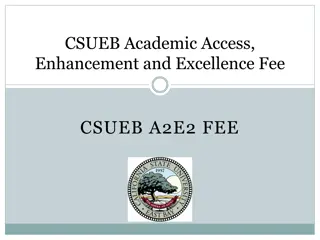Enhancing Teaching Effectiveness: Models and Measures for Academic Excellence
Explore the essential elements and criteria for effective teaching, sources of evidence, and models utilized in evaluating teaching effectiveness at Concordia. Discover the importance of defining teaching excellence, setting goals for faculty development, and utilizing measurement indicators for continuous improvement efforts.
Download Presentation

Please find below an Image/Link to download the presentation.
The content on the website is provided AS IS for your information and personal use only. It may not be sold, licensed, or shared on other websites without obtaining consent from the author.If you encounter any issues during the download, it is possible that the publisher has removed the file from their server.
You are allowed to download the files provided on this website for personal or commercial use, subject to the condition that they are used lawfully. All files are the property of their respective owners.
The content on the website is provided AS IS for your information and personal use only. It may not be sold, licensed, or shared on other websites without obtaining consent from the author.
E N D
Presentation Transcript
Leadership and Challenges: Models and Measures of Teaching Effectiveness at Concordia Susan Gallanis, Elizabeth Evans, and Catherine (Kate) Robertson CELT March 3, 2023
Today's Session Welcome Share in chat: What is the most important element/criteria for effective teaching Framing Our Concern as Leaders Sources of Evidence for Effective Teaching 2023 Models in Use Observations including support Blackboard Data
Why do we need models ? Many good minds have attempted to define teaching excellence To provide starting points for dialogue on what is excellence To suggest goals for faculty development programming To provide conversation starters for formative observations To provide measurement indicators for continuous improvement efforts To provide a framework for summative faculty evaluation
Sources of Evidence 2023 Student Ratings Syllabus Review Summative Teaching Observations Participates in Development Programs/Degree Works Annual Faculty Eval and Reflection Three Year New Faculty Programming with Mentoring Blackboard Learn Data Other https://celt.cuw.edu/models-measures-teaching-effectiveness/
Models in Use Nine Principles of Good Practice Student-Instructor Contact Time on Task (time investment in coursework) Communicate High Expectations Give Prompt Feedback Cooperation Among Students Respect Diverse Talents and Ways of Learning Encourages Active Learning Consistently Use Assessment and Quality Improvement Reflect the Mission and Values of CU www.cuw.edu/celt and www.cuaa.edu/celt
Models in Use Improvements in Evaluation Process 2016 Student Ratings Revision: what can students legitimately provide feedback on? The instructor: was well organized and made effective use of course time answered questions clearly and effectively communicated high expectations for student success demonstrated the relevance and significance of the subject matter challenged students to do their best work provided timely feedback provided useful feedback was available and approachable The instructor s teaching strategies, activities, and assignments were effective for learning
Models in Use Improvements in Evaluation Process Updated the teaching categories 2015-2016 Faculty Teaching Effectiveness Evaluation In response to 2015-2016 Strategic Plan Annual Institutional Priority Develop a robust method to assess faculty teaching performance and improve faculty accountability for academic rigor and student learning, a faculty group met with Dr. Dvorak, reviewed literature about faculty teaching and evaluation, and developed a multiple perspective model for effective evaluation of teaching: 1) a teaching observation (in-person or online) 2) a course content/teaching material review by a disciplinary peer 3) a faculty self-reflection
Models in Use: 2019 Teaching Observation Revision Organization and Clarity, Presentation Skills (Content-specific Communication by Instructor), Presence and Rapport Instructional Strategies Faith & Learning, Discipline-specific Expertise, Overall
Models in Use: 2019 Teaching Observation Revision The Teaching Observation Form and resources are here https://celt.cuw.edu/teaching- observation-process-and-form/. Also available in the Department Chair/Program Director Resources channel on the Employee tab of the portal. The form is in the Forms Repository. CELT offers formative observations and sessions on how to do summative observations
Models in Use: 2022 Barkley & Major Engaged Teaching Foundation Seeks to Learn about Teaching /How Students Learn Planning Provides Appropriate and Rigorous Course Content Develops Course that is Organized, with High Clarity of Information Sets clear expectations through assessable outcomes; aligns course outcomes to PLOs and GLOs Provides course design that aligns assessments to outcomes Faith and Learning Connects Christian Faith to learning in discipline and GLO #1 Christian Faith Is comfortable sharing faith and Bible knowledge
Models in Use: 2022 Barkley & Major Engaged Teaching Climate Designs Engaging Learning Tasks; strives to engage students Is Available, Approachable, Personable Supports Diverse Ways of Learning, uses Universal Design for Learning (UDL) Gives Useful, Prompt Feedback Methods Uses active learning, lectures effectively Uses variety of teaching methods, including assignments Creates collaborative learning opportunities Improvement Seeks feedback from students, peers, supervisors Assesses and evaluates own teaching and seeks to improve, uses available Barkley, E. F., & Major, C. H. (2022). Engaged teaching: A handbook for college faculty
Blackboard Data Warehouse of data: Blackboard and Banner Blackboard data reports to help answer the question What is teaching excellence? Data are indicators Focus on Instructor engagement where do we see instructor engagement in a Blackboard course? Online course: Blackboard is the teaching environment Other instructional methods: Blackboard is not the only teaching environment
Instructor Engagement Reports (Climate) Instructor provides prompt feedback Report: Days to Grade
Instructor Engagement Reports (Climate) Instructor strives to engage students Report: Discussion Forum Activity
Instructor Engagement Reports (Climate) Instructor presence and rapport Report: Days since last course access























